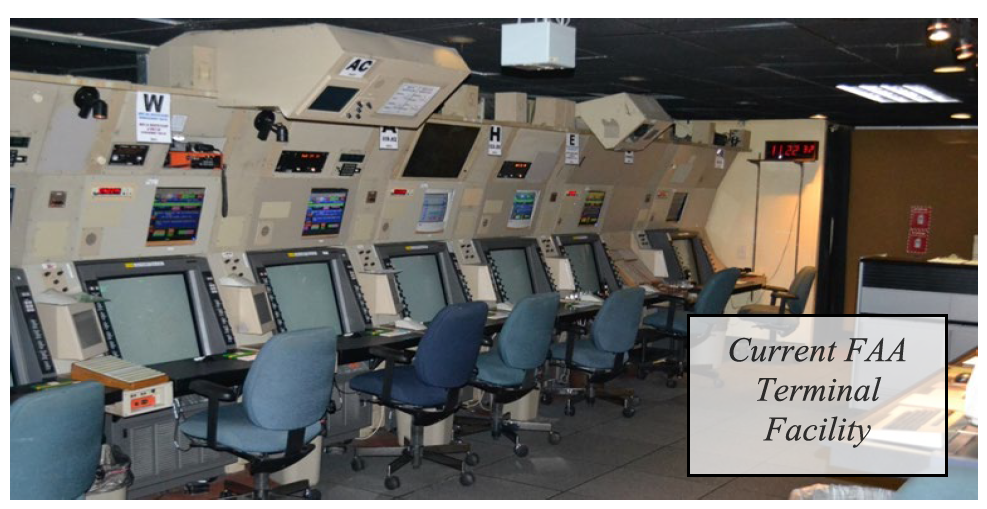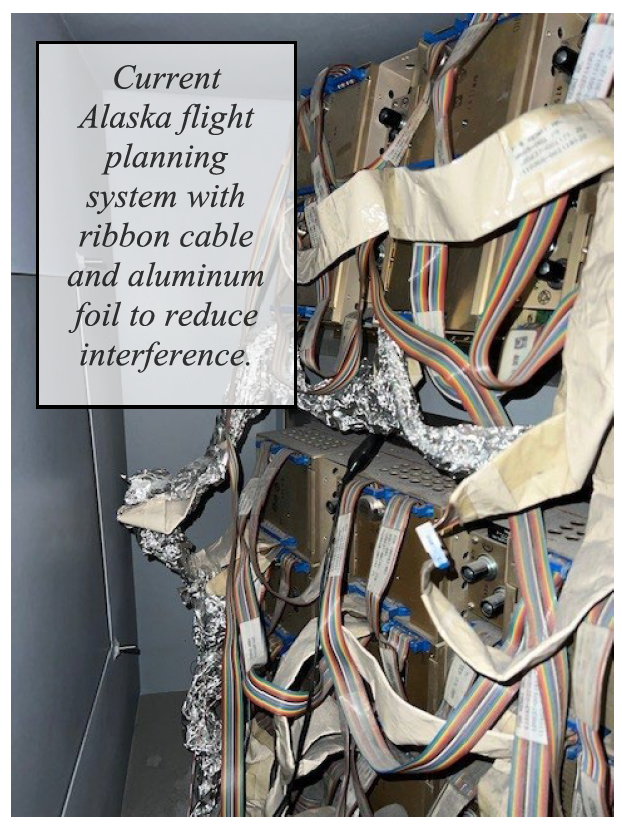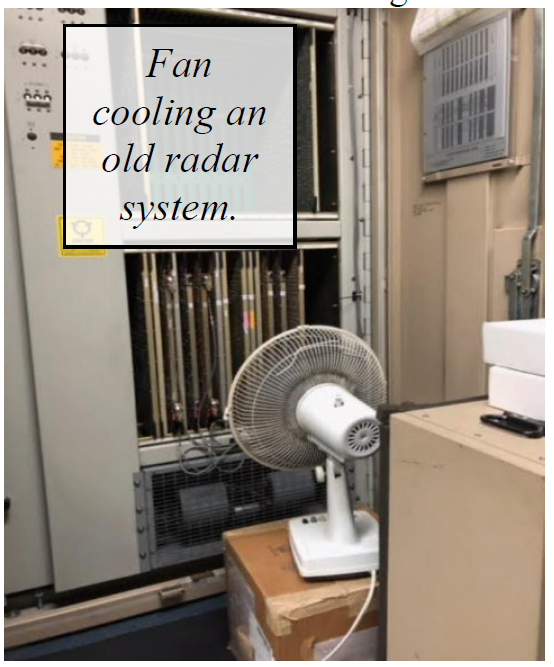A new government watchdog report out of the Trump administration lays out why air traffic control modernization has failed, but casts down on their own ability to fix it simply through force of spending an additional $30 billion.
For the past two decades, the Federal Aviation Administration has been trying to modernize air traffic control. The effort has been NextGen. And it’s been a disaster.
NextGen was supposed to transform how planes navigate and communicate, making flights quicker, safer, cheaper, and more environmentally friendly. A new DOT Inspector General’s report looks at how badly the effort has been bungled.
- NextGen was pitched to deliver $213 billion in benefits by 2025. Over time, the FAA reduced its expectations significantly. Now, they project just $36 – $63 billion in total benefits by… 2040, with only about $10 billion actually realized in the first 20 years of trying.
- Important technologies meant to modernize communication between pilots and controllers, improve weather forecasting for flights, and manage airport traffic have all experienced severe delays. Several of these core programs are now scheduled to be completed in the next decade. One of the most significant programs, intended to manage flight traffic efficiently at airports, has had its scope dramatically cut back, reducing the number of airports that benefit from 89 to just 49. Meanwhile, the cost of this program has ballooned.
- A crucial upgrade to the voice communication system used by air traffic controllers was canceled after years of delays, forcing controllers to keep relying on outdated technology first put into service 40 years ago. This cancellation means spending hundreds of millions of dollars just to maintain these old systems.

In 2025, the FAA will close the official NextGen office, even though many promised improvements still haven’t materialized. The FAA is launching a new modernization effort that at the outset is expected to cost more than $30 billion. But that effort so far doesn’t really address the FAA’s mistakes handling past upgrades.
The report identifies 11 broad areas of failure:
- Overly Ambitious and Unrealistic Planning. The FAA kept promising benefits that were too large, timelines that were too short, and projects that were too complex for it to manage.
- Shifting Goals and Requirements. Requirements kept changing, making it hard for teams to hit moving targets. Frequent changes in what was expected from technology and programs delayed deliveries and escalated costs.
- Poor Contracting and Acquisition Practices. The FAA relied heavily on large, decade-long “umbrella” contracts rather than smaller, modular agreements. This decreased competition, limited flexibility, increased costs, and led to weaker accountability. Poorly managed developmental contracts (totaling around $1.7 billion) lacked sufficient controls and oversight, wasting resources.
- Weak Program Oversight and Governance. Frequent turnover in leadership, fragmented responsibilities, and multiple reorganizations disrupted continuity and accountability. The organizational instability contributed significantly to missed milestones and confusion over priorities.
- Underestimated Technical Complexity. The FAA underestimated how complicated the integration of new systems with legacy systems would be. Technological interdependencies across multiple programs were not properly managed, leading to cascading delays.
- Insufficient Risk Management.b The FAA did not effectively manage risk at an enterprise level. They often did not anticipate or prepare for setbacks that could delay or undermine projects. Important lessons learned from setbacks were not sufficiently applied to future projects.
- Poor Industry Collaboration and Communication. After taking direct control of collaboration groups that included airlines and industry stakeholders, communication deteriorated. Airlines and other stakeholders became frustrated, as delays prevented them from benefiting from investments they had already made to equip aircraft for new technologies.
- Parallel Operation of Old and New Systems. Because the FAA failed to retire older systems on schedule, it had to maintain costly legacy technologies alongside their replacements. This duplication drained resources that could have accelerated new technology implementation.
- Lack of Real-Time Benefit Tracking and Adjustment. The FAA did not effectively measure the actual benefits of deployed technologies or adjust priorities based on updated data. As a result, limited resources were often poorly allocated.
- Inadequate Workforce Training and Preparation. FAA employees, especially air traffic controllers, were often not sufficiently trained or prepared to utilize new technologies promptly, delaying realization of benefits.
- Weaknesses in Cybersecurity and System Resilience. The FAA was unprepared for several significant disruptions, including outages caused by cyber issues and system vulnerabilities, highlighting gaps in resilience and cybersecurity.

In summary, the report paints a picture of systemic mismanagement, overly ambitious expectations, insufficient oversight, poor planning, and inadequate stakeholder engagement—all combining to derail the NextGen modernization effort and prompting the FAA to essentially restart with yet another major initiative.
I’m not sure they’re really getting at the crux of what’s wrong here. You have a bureaucratic system, and the regulators are also the service providers. They regulate themselves, which leads to very little accountability. Budget politics lead to overpromising and annual appropriations to poor investment choices even within the context of poor project scoping and broad mismanagement.

Crucially, though, the issues identified in the report aren’t really being addressed by the Trump administration’s new air traffic control system effort therefore there’s little reason to expect a different outcome.
(HT: Bob Poole)


Ah, so, a rare bipartisan topic… both sides fail at properly funding and upgrading ATC. Shameful.
Perfect example of why I don’t want government running my health care.
The current administration is spending money that could have been invested here. Think ballroom that looks like a convention hall.
We could have piggybacked on the Canadian system or jointly develop the Gen 2 version. That ship has sailed, at least for a few years.
Our system has a major failure point called GPS. Everything from navigation to timing synchronization relies on GPS.
We need modernization and redundancy
@This comes to mind — If you really don’t want this ‘government,’ maybe #47 should resign. (Oh, wait, you’re cool with an authoritarian, as long as He’s ‘your guy.’ Got it. Keep lickin’ those orange ba…)
How… ‘wE gOtTa GeT tHa GoVmEnT oUtTa Ma MeDiCaRe!’ …of you.
(Naw, man. We need a responsible government that functions properly to address the needs of its people.)
Well said, @Doug!
The problem is not partisan.
The problem is that ATC and other large systems that require heavy automation and a highly skilled workforce cannot be funded w/ the constant change in leadership and priorities that change every 2 years.
ATC has to be run like a business both for long term planning and funding and also for the short-term to deliver regardless of whatever other pressures exist.
Let’s face it – it was human error, not automation, that failed at DCA. Those “supplemental” fans are working.
Even the failure of communications affecting EWR cost no one any lives and the FAA moved pretty quickly to fix it.
And those of you that love to talk about Canada’s ATC system never bother to mention that US airlines have far better on-time than their Canadian counterparts.
US airline hubs at MSP, ORD and DTW have far better on-time than Canadian airline hubs in eastern Canada.
@Tim Dunn — Well said on this topic.
Any comment on the Delta ‘Nightshade’ incident?
Maybe Delta airlines can fix this
Americas answer to premium everything 😉
@Doug
That ballroom is funded by donations and not the federal government despite that fact it will benefit them.
@Walter Barry — So what? Funding isn’t the only issue. Our country is not for-sale to the highest bidder, especially not the Peoples’ House. If anyone other than #47 did this, such as #44, you’d’ve stormed the Capitol again.
@Walter Barry — Clean-up on aisle 4… there’s a story about a black TSA agent from earlier today that needs your bigoted ‘hot take’ ASAP.
This has been going on since around 1980 when I was a subcontractor to DOT.
The operational systems and regulatory systems need to be disconnected, with the operational systems (ATC) having control of its own budget, not under Congressional control. This has worked in other countries.
This will let ATC update its equipment as needed, instead of when Congress says it can. Back in 1980, Congress wanted the FAA to continue using 1960’s era computers because they had been bought and paid for. Not that they could do the job any more. And when the FAA asked for the ability to update the computers, congress essentially said why? You didn’t get it right last time.
That was 15 years earlier. Maybe the ATC system could have been done better in the 60’s, but maybe not. The choices made then were reasonable. Maybe not the best, but reasonable. Computers had advanced so much in that time the old ones were suitable to be boat anchors.
Get the operational systems on their own budget.
@1990
The ballroom is an improvement to what was there before as was the patio in the rose garden. He’s making the people’s house great again and better. We all should be thanking him for donating this gift to the American people.
This is an interesting photo. This tracon room is modernized. It has square scopes (digital displays). All radar scopes prior were round and had a moving sweep. The digital scopes didn’t happen until the mid 2000s around 2007.
Walter, just like the Wall and other lies spread mentally unhealthy individuals, we cannot trust the irrational judgement of the fool elected. He’s trashing the white house as he has abandoned Americans
Marion Blakely, George W’s FAA administrator got promoted to the head of the AIA at probably more than 3x her federal salary in return for pushing Next Gen.
A lot of people posting don’t seem to understand the core issues in ATC. ATC cannot & should not be “run like a business!” A business must have the prospect of failure in order to function in the marketplace. ATC cannot be allowed to fail in any sort of system wide way. It is fundamentally a monopoly, which means that marketplace forces don’t operate.
Furthermore, people are preoccupied with delays while assuming that safety will happen by itself. ATC is primarily about managing routines while being able to respond to failures in ways that prevent deaths. The “human error” that created AA5342 took place in an office, not DCA tower or the cockpit of the UH60. It was a matter of too many “important” people demanding conflicting priorities that lead to those deaths, not the ATC operation. Delays are often a similar issue of every airline wanting to schedule an 8am departure out of LGA when only one plane can actually depart LGA at 8am.
So I guess the ADSB upgrade was an abject failure? To say all the money was wasted is extremely short sighted and a flat out lie.
So, who got the contracts and didn’t do the work? Who didn’t do the work and then asked for even more money? Who signed off on the initial contracts and then gave them more money when they didn’t deliver that? Who was supposed to monitor and oversee all of this?
In the end, ZERO accountability by individuals or corporations. And certainly no accountability by government officials — whether elected or bureaucrats.
I’ve lost track of how often I’ve seen this sort of crap in government work. It’s easy to waste other people’s money when there’s no consequences for doing so. It’s why we can’t have nice things.
@Walter Barry — No, the people of Argentina should be thanking him; $40 billion (not million) of our taxpayers money in a bailout to those descendants of Nazis who fled… so much for America First. Sounds like Argentina First. You/we all got conned, a second time.
First and foremost, the FAA itself needs an overhaul. A broken system cannot be expected to fix broken system no more than an irrational person can be expected to behave rationally.
Case in point: look at the way the FAA handled the Boeing crisis. Bold and undeniable warnings were repeatedly disregarded by the FAA….and even in the wake of planes crashing, people dying, and RED HOT alerts that more planes would go down, the only thing the FAA scrambled to fix was their own public image. The only thing they worked to maintain was plausible deniability and the only thing they worked to avoid was accountability.
And of course there are other systematic factors and entities contributing to the FAA’s habitual “failure-gate”….there always is.
But in the spirit of not being reductive, this issue can (and should) simply be reduced to this: the FAA is a massive failure and cannot be expected to fix themselves.
Boy oh boy! TDS is strong. Can’t stay on topic. Good thing the cry babies aren’t in charge of the ATC issues. Oh wait, they were. Sorry lot all of you.
The removal of ADF indicates the mindset behind the failures. Newer isn’t necessarily better.
@1990
Yeah, you’re part of the problem. Lazy partisan, easily manipulated into blaming anyone but how you vote. Please, please with some sugar on it, stop voting. You’re diluting the votes of others trying to right the ship.
I’m recently retired from the FAA after 34 years. NEXGEN was a complete failure. Nothing is going to change until they privatize the agency. Training, technology, and management all need to be held accountable. NATCA is the biggest obstacle.
It’s just like the homeless. If you never actually solve the problem you can spend billions and billions with people at the top and in the consulting class getting rich. Solving the problem ends the grift. Just look at California. Well over $25 billion and it has become a mecca for people that want to do drugs, have sex out in the open, live in a tent and have the government provide their food, water, medical care and drug paraphernalia and in some cases supply. They just have to go out every couple of days and rob a CVS with no consequences.
The FAA just wants to complain about it and have endless ATC holds of air travel.
Express your venting to your congressman and hold them accountable for positive change as some here have eloquently stated
I started at the FAA in 1980 and retired in 2007. Upgrades were promised and not delivered. The contractors made $ but never delivered. Sad that 45 years later the system still needs upgrades.
The FAA will continue to stay feckless, incompetent, and wasteful, as long as it’s managed by politicians and staffed by government workers. The only solution is to privatize it and allow it to be run by professional managers and private sector staff. If you don’t care about privatization of the FAA, you don’t care about the FAA and consent to the status quo.
From a contractor that worked with the FAA at Metron for 4 years, the incompetence is laughable within that organization. Say what you will about the private sector, but I dare you to find any company with a $20 billion annual purse that is as upsidedown. The problem there is the PEOPLE, people who In any other time period in our history would be bagging groceries or shoving manure. I absolutely fear what those trainables will to do aviation in the coming decade without drastic changes.
Reading the comment section really reflects why this country can’t move forward. If you think it’s strictly “the other guys fault,” you aren’t even worth listening to. This is a symptom of bipartisan nonchalance, so much so, that no one even flinches over the amount of money we’ve sunk into a company that we hold no one accountable for. If a contractor screwed you over, you’d be shouting until eternity. Here, the government wasted billions, with nothing to show, and all people can do is blame the other side. This isn’t something that happened in the last 4 years, nor is it because current POTUS is building a ballroom with donated funds. While people bicker over politics, people are dying. If you have been paying attention to all the near misses, minor bumps, and complete disasters lately, you’d be more concerned about the people actually in the plane, instead of the guy who happens to be at the head of the table at the moment. Let’s just fix the problem, you can blame whoever you want afterwards.
I assume the high volume, zero quality poster replied to my post. Just want to let everyone know, I don’t read posts from posters like that. It frees up a lot of time for higher value activities. And, frankly, banging my head against the wall is a higher value activity than reading those posts.
These programs are meant to last as long as the employees can achieve their high 3 and then retire.
FAA tech center.
Best kept secret in Government employment.
Never ending project and failed programs.
@Jeff — Ah, yes, just blame the other side; solve nothing. Good point. Surely, a one-party system where your team is forever in-charge, led by an infallible king is better… /s
@This comes to mind — Yet again, you added nothing, except to whine about your fellow commenters. Do you have an actual point, or just ‘hate’ for others?
No stained Blue Dresses allowed in the Ballroom.
I’m just curious – is the FAA large enough to just keep acquiring/maintaining the old systems at scale? It seems like at some point we might just be better off ditching “modernization” in favor of keeping the old systems around. “Costing hundreds of millions of dollars” sounds bad, but if you’re paying tens of billions for the upgrades the payback timeframe might be too long to be worthwhile.
Michelle gets it!
@Mike P — What a pleasant surprise to hear that from you, Mike, since you typically just ‘blame the other side,’ or wish for anarcho-libertarianism, which is certainly not the answer either.
ATC is not the problem, the system is not upgraded by ATC. ATSS ,2101s upgrade and maintain the equipment and it is run by people who only care about their “top three” for their retirement. The FAA is trying to save money and they are doing it my cutting NAS upgrades, automating more systems, taking out the human technicians that actually maintain the systems, to save money, but still maintain the multi-level of supervision that are useless. I have to get approval from 5 supervisory levels to spend 10 dollars, but the supervisors ,that are only looking for the next higher job, get 25,000 to 40,000 dollars to move between jobs, lasting about one year, to pad their retirement. It’s not ATC or the ATSS, it’s the management of the ATSS that are the biggest block to modernization and safety
I loathe Trump. But, spending money contributed to build a ballroom isn’t an issue I focus on. His ever fluctuating trade policies, his lack of concern over deficit spending, his lack of grace, those things are what draw my focus.
This is a great example of a grand engineering challenge. As long as this is subject to political leanings and contractors that are more interested in selling PowerPoint than delivering results nothing will change. If you want to fix that problem it will require a sizeable team of engineers (this is a mentality of having a passion for solving problems and a skill set) and protect them from all bureaucrats. To be fair to the government this would fail just the same if it was done by a company. Just look at every technology transformation in F500.
I doubt this will ever happen as it takes courage beyond corporate and government organizational incentives.
@This comes to mind — The ole ‘I don’t like X, but X had some good ideas…’ *facepalm*
Glad you at least recognize the tariffs are a horrible idea (and also unconstitutional as Congress is supposed to set those).
And, yeah, for the decades of conservatives pretending to care about the debt and deficit only to just add to it significantly, not for helping the needy, but for enriching the already extremely wealthy with tax cuts.
The ballroom matters because it shows a lack of priorities, and a willingness to break more laws, rules, and norms; if anyone else from the other ‘team’ had destroyed a third of the White House on a whim, without review or approvals, your side would have attempted another coup. Get real.
As to the actual issue here; it’s simple. Bipartisan funding and reforms to the FAA, investing in better equipment, training, and support for the people who make it all happen. Instead, we’re solving nothing and using outdated technology from a bygone era. How long until more people get hurt…
If ‘he alone can fix it,’ he sure hasn’t even tried on this topic. Psh.
Maybe now is the time to reconsider Airborne Self-Separtion. This was dismissed by controllers around 2010.
With over 40 years of experience in air traffic control maintenance I could tell you that the current system is a disaster. It does not matter what the system is (Radar, radios, automation,……) the FAA is 20-40 years BEHIND in technology. We are still using AM radios. Yes, the SAME “AM” that was on car radios years ago and got interference every time you went under a power line.
Expected.
Now the current Admin will be fired and incomes will be expected to operate in an understaffed and underfunded conditions
I concur AM seems outdated but what is the solution for something that requires an immediate broadcast, acknowledgement and action? A text? FM’s shorter range? Satellite’s lag?
If they could be able to trigger a red light in the cockpit when ATC is calling you, like a reverse transponder/ident,, that would be ideal instead of listening with half an ear for your call sign while doing many other things at once. Watch any youtube video of a smaller plane being vectored around in busy airspace…
The military gets the money it needs. The US military is the best on the planet, by a LONG ways.
The military is on a 10 year budget cycle, because they have complex tech that needs time to get implemented. They are not subject to losing funding during a gov’t shutdown, as they are an essential service.
If the FAA got the money they needed, was on a 10 year budget cycle, and was not subject to losing funding every time the Dems and Reps can’t get along, this would not be a problem.
It is ALSO true, that the FAA is trying to promote aviation and help private sector aviation, while at the same time overseeing safety. These are two competing concepts. The FAA should help the airlines, and the NTSB should be the safety side.
The situation sucks. It is, basically, Congress’ fault for not doing their job, and, Our Government, overall, for not preventing massive Corruption, which has caused the below:
The US used to have THE BEST ATC, the best airports, the best airlines, the best airplane manufacturers, etc. We gave it all up so The Rich could have more. money.
Elon, where are you ? We have a small job for you to do.
In response to the idiots who changed this into a trump thing on their post s, I am very happy that Trump cares about our country and is having the ballroom built, years and years of scamming taxpayer dollars and pissing them away is the reason for these problems mentioned in this article